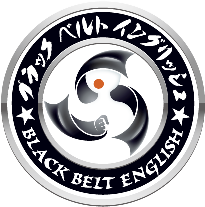Opening the dojo!
In March of 2009 we decided to open our dojo and begin offering classes in the martial arts. Although we offer other kinds of classes now (like English conversation classes), Black Belt English first began as a karate school. As any new business owner must feel, we were anxious on opening day. Would anyone come? How would people in Japan feel about an American teaching karate in their country? Would the students understand my directions in class since I will be speaking in English?
To let people know we were open, we placed some colorful flags out in front of the house near the driveway. We then hung a simple banner displaying our website address; but we soon found out Japanese people usually don’t search for anything by directly typing in an address like that. Following this revelation, we placed a larger banner on the long stretch of bushes indicating we were open and accepting applications and we also placed ads in the phone book and local paper!
At first, I taught the martial arts classes in much the same way I had in the United States. One immediate change was that I was only speaking English, so I had to work hard to refrain from directing students in Korean like I had in America (since my main teacher instructed that way). Many students were lost at first, not completely understanding my directions. This led to them being a bit shy and hesitant, so the classes seemed to have low spirit. They really did not look and sound like a good martial arts class – and this was my fault.
Listening carefully to my wife’s advice and continuing my research, I began to change my teaching style a bit. Less talking and more demonstrating. I also worked hard to keep my English simple and clear; and one of the best decisions I made was to start having the students repeat what I had just said so that they could retain the information.
In time, the Karate in English classes started to sound and look much better. Their confidence in their martial arts skills was increasing, and so was their confidence and ability in English. Our first ranks tests went quite well, and the students did a wonderful job of putting forth their best efforts during the examinations.
My school had started to grow…And I felt I was growing as a teacher…and as a martial artist!



